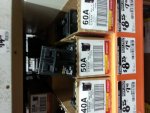Well there are a few other ways that are indeed easier however I question safety with the methods involved. Youl could get two large electrodes like say steel pipes and hook them both to one of the hot leads coming out of the generator ie. L1, and L3 in single phase mode. You could then fill up a plastic (key here is use a plastic tank for your safety) tank with water and then add some salt to it stir it around and then put both of the pipes in the tank no opposite sides and flip the breaker. YOu will get a load and it will vary depending on what the molar concentration of the salt water solution is. Id start out with a pretty small amount of salt and see what happens and then add more sodium chloride till you get the desired load. Again this method seems way more dangerous to me and a good way to get a really good shock but it is pretty cheap and easy.
Another option would be get a long steel cable like 100 feet long and string it up on some poles so it is not touching the ground at all put it on some insulators on the poles and again hook one lead from L1 to one end of the wire and the other L3 to the other end of the wire and throw the breaker. That wire on the poles will get really really really hot and put a pretty decent load on the generator. If it is to great a load it will throw the breaker out and you will have to get a longer cable then to make it work. Again you can see the safety concerns with this method as well.
One other pretty safe way to test it but $$$ is go buy one of those huge ass 3 phase electric heaters and hook it up to the unit and just turn it up to you are at 100% load. I think they have them up to like 25000 watts or something crazy like that then again your looking at at 1500 to 2k investment in the heater but very safe

So if you do any of the above mentioned methods not including option 3 I take zero responsibility in any bodily injury or harm you cause to yourself but they are cheap and easy. Im sure someone else will chime in.
Lee



